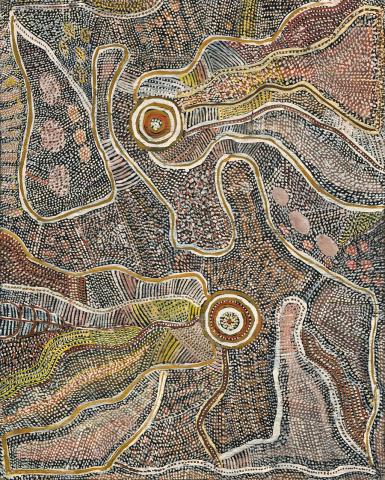WATER DREAMING
Attributed to Johnny Warangkula Tjupurrula
synthetic polymer paint on plywood
52.5 x 42.0 cm
Private collection, Melbourne
Water Dreaming with Rain and Lightning, 1972, synthetic polymer paint on composition board, 60.0 x 50.0 cm, in Laverty, C., Laverty, E., and Kleinmyer, J., Beyond Sacred: Recent painting from Australia's remote Aboriginal communities; The collection of Colin and Elizabeth Laverty, Hardie Grant Books, Prahran and Bambra Press, p. 39 (illus.)
Man and Naughty Boys' Water Dreaming, 1972, 50.0 x 60.0 cm, in Bardon, G., Papunya Tula: Art of the Western Desert, McFee Gribble (Penguin Books Australia), Melbourne, 1991, pp. 54-55 (illus.)
For a discussion of the Water Dreaming theme see: Bardon, G. and J. Bardon, Papunya, A Place Made After The Story, The Beginnings of the Western Desert Painting Movement, The Miegunyah Press, Melbourne University Publishing, 2004, p. 49 and for further discussion on the artist and the Water Dreaming see ibid p. 157 and p. 61 (Map 8) for a detailed map of the artist's country (homeland).
This painting on board was most likely executed around 1972/73 at a time when the artist was producing a series of exquisite paintings based on the Water Dreaming theme. Containing all the elements of what Geoffrey Bardon referred to as the 'calligraphic motifs' connected with the Water Dreaming, this painting incorporates rain, lightning, waterholes, cliffs and bush tucker. Utilising a technique of overlaying layers of fine dots, Warangkula established an analogy between broken patterns of dotting and vegetation and topography. As curator Judith Ryan notes, Warangkula was the first to devise a style that existed on an aesthetic plane... by colour mixing and layering of dots laden with white, he obscured symbols of narrative or signs of secret men's business in ways that prefigure the dot field paintings of Emily Kngwarreye'.1
In his book Aboriginal Art of the Western Desert, Geoffrey Bardon describes the painting of Johnny Warangkula as of major significance, 'they are strictly Aboriginal stories without conscious European influence and yet they can be measured by the modern Aesthetica his work has anecdotal intimacy, a candid freshness and spontaneity that beguiles by its individuality'.2 Portrayed by Bardon as a happy, expressive man who was a tireless worker, Tjupurrula is credited with developing a dotting method that was particularly admired and was later adopted by other painters, eventually becoming the convention for Western desert painting. Bardon described this style as 'tremulous illusion' where overlays of stippling and dotting gives the paintings a three dimensional quality.3
Tjupurrula's ongoing thematic engagement was with the Water Dreaming, manifest in his intricate depictions of the permanent soak of Kalipinypa and the waterholes of Tjikari and Ilpili which display a determination to paint the complexity of his country.
1. Laverty, C., Laverty, E., and Kleinmyer, J., Beyond Sacred: Recent painting from Australia's remote Aboriginal communities; The collection of Colin and Elizabeth Laverty, Hardie Grant Books, Prahran and Bambra Press, p. 36
2. Bardon, G., Aboriginal Art of the Western Desert, Penguin Books, Melbourne, 1991, p. 53
3. Bardon, G., and Bardon, J., Papunya, A Place Made After The Story, The Beginnings of the Western Desert Painting Movement, The Miegunyah Press, Melbourne University Publishing, 2004, p. 157
